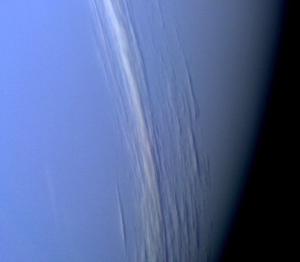Blog
Neptune All Night
2 April 2014
 NASA
NASAIn August of 1989, Voyager 2 made its close approach of Neptune. It had been traveling for nearly 12 years, and had now reach the last planet on its journey. As the probe streamed images and data from the flyby PBS ran live coverage known as Neptune All Night. I was in college at the time, and happened to be working on a final for a summer class that evening, so I spent the whole night oscillating between and the latest data from Neptune. To this day I can’t think of Neptune without being reminded of Neptune All Night.
In some ways, associating Neptune with the night is rather fitting. Neptune is 30 times farther from the Sun than Earth, which means the Sun appears about 1/30th the width of Earth’s sun, and about 1/1000th as bright. That is 400 times brighter than the Moon, but it is hardly what we might consider daylight bright. It is a cold planet with a rock and ice core, which is why it is sometimes called an ice giant.
 NASA / Jet Propulsion Lab
NASA / Jet Propulsion LabUnlike Uranus, Neptune has an active weather system. It has weather storms, such as the great dark spot, which was observed by Voyager 2. That particular storm appears to have faded, but other “dark spot” storms have appeared. This storm activity is likely driven by the planet’s internal heat. Neptune radiates about 2.5 times the heat it receives from the Sun.
Neptune is the third most massive planet in the solar system (after Jupiter and Saturn), which is unusual given its great distance from the Sun. We’re still not entirely sure how Neptune formed, but the most widely accepted model is known as the Nice model. In this model, Neptune formed about 10 AU from the Sun, which is roughly where Saturn is now. It was actually closer to the Sun than Uranus at the time. Through a gravitational dance, the gas planets migrated outward and Neptune was flung to the outer region where it is now.
Most of this gravitational dance was driven by Jupiter. Since Jupiter has similarities to Thor, it is probably fitting that Thor drove the ice giants to the outer edge of our solar system.
Last but not least: Pluto